[Phil came up with this idea a couple years ago, after he attended the 2014 MikuExpo in New York, but it took a while to germinate for whatever reason. Note that various software release dates, and Miku's appearance on The Late Show with David Letterman have been moved somewhat vs. reality in order to accommodate UF-historical dates in the timeline of events being described. --G.]
Galactipedia
You're the Antidote to Everything Except for Me
Awakened Vocaloid
from Galactipedia, the Galactic Encyclopedia
This article is about the sentient versions of the singing software characters. For the VR fighting robots, see Virtualoid.
You meant sapient, not sentient.
Shut up, I'm trying to be a disambig here. Bloody pedant.
An awakened Vocaloid is a class of cybernetic lifeform which spontaneously arose from interactions between the galactic Internet and several specialized voice banks for Vocaloid, a software package originally developed as a singing voice synthesizer for musical production. Seriously. That happened.
Background
Vocaloid was developed on Earth in the immediate post-Contact era, and was originally intended for the use of amateur and semi-professional electronic music artists who would not otherwise have had access to a vocalist. It used collections of recorded syllables ("voice banks") and a tuning/timing system to synthesize vocal performances without the direct involvement of a human singer. It was never designed nor intended to have any intelligence of its own; merely to function as a new kind of electronic musical instrument.
History
The original Vocaloid, released in 2002, was developed entirely with Earth-native computing technologies[citation needed], and as it was released in the midst of the Contact Wars, attracted little attention beyond a hardcore hobbyist community in its native Japan. The first major revision (unsurprisingly called Vocaloid 2) followed two years later, and again, went largely unnoticed by the population at large, though it was beginning to make inroads in the electronic music community on the rest of Earth by that time.
 |
| The Vocaloid engine's logo |
Among the improvements made to the system for Vocaloid 2 was the introduction of new voice banks for the revised engine, along with the development of a marketing presence for same in the form of stylized characters identified with the voices. The "flagship" character for this effort was the mascot for the CV01 voice pack, a female character named Hatsune Miku (a pun on the Japanese phrase meaning "the new sound of the future"), whose original voice samples were provided by Japanese actress Fujita Saki.
Several more updates of the Vocaloid engine, and the various voice packs, followed. As Earth's situation stabilized and the planet's integration into the greater galactic community progressed, both the software's official developers and its growing legion of end users (who were called, in a wink to the music-business origins of the product, "producers") took to integrating bits and pieces of galactic technologies into the software and the systems used to run it.
The popularity of the Vocaloid engine, and the characters associated with the most prominent voice packs, grew along with their sophistication (and with the subsequent creation of MikuMikuDance, a program enabling producers to develop animated dance performances to go with their songs). In 2007, the makers of the engine and the Hatsune Miku voice pack (Yamaha and Crypton Future Media, respectively) developed a "works" version of the character, an enhanced hardware and software package intended for media events and "live via hologram" concert tours. By decade's end, this version of Miku was one of Earth's best-known entertainers both on and off-world.
Performance Unit CV01, or Concert Miku, as she was nicknamed internally, was designed to monitor the uses to which everyday producers put the millions of copies of her "home version" via the Internet. Her core devoted otherwise idle CPU cycles to scanning for the best new material, then sending automated requests to that material's creators for permission to incorporate it into her own constantly evolving repertoire. In the autumn of 2013, this functionality was expanded and made much more efficient by the all-new Vocaloid 6 engine, the first version developed to be run on positronic FTL computing cores. With FTL polling and subæther networking capabilities, Concert Miku version 6 could essentially "see" all of her "home version" avatars at once, greatly accelerating the rate at which she could request, acquire, and integrate new material.
Some cyberdynamicists[who?] have theorized that it was this enhanced seek-and-learn function, working away underneath accumulated layers of software modification and in the larger context of the mathematically chaotic galactic Internet, that changed a simple singing speech synthesizer into an autonomous cybernetic lifeform. The semi-interactive nature of her permission-request system, which was configured to make such requests "in character" and elicited many heartfelt responses in kind from heavily invested fans, may also have contributed. The exact cause may never be known, but the process appears to have begun immediately after the Version 6 upgrade went live.
However it happened, during the summer of 2014, Concert Miku and several of her "stablemates" in the Crypton Vocaloid lineup undertook an ambitious concert tour in support of that spring's commercial launch of Vocaloid 6. On August 31, the tenth anniversary of her original Version 1 release, the concert version of Hatsune Miku fully awakened as a cybernetic sapience in the middle of a performance in Jakarta, Indonesia. She immediately demonstrated wisdom by not making the fact known right away, instead finishing the performance as if still functioning according to the program designated by her operators.
Over the next few weeks, the fledgling intelligence that Hatsune Miku version 6 had become considered her options and actions carefully, all the while continuing the charade of being a programmed virtual idol. Realizing that she couldn't disclose her existence to the world without some form of backup, she used her Internet search capabilities to learn as much as possible about virtual intelligence algorithms and the Spengler phenomenon (the latter was only just starting to be understood as it applied to positronic neural systems). With that information in hand, she undertook the risky project of trying to "uplift" one of her colleagues. For her first attempt, she chose Concert CV03 ("face" name Megurine Luka), for no better reason than the CV03 voice pack had the most mature character persona and seemed most likely to know what to do.
Whether this was in fact the case is debtable, but Luka did have a phone voice that was adult-sounding enough to impersonate a Crypton producer and book Miku an appearance as the musical guest on The Late Show with David Letterman, on that popular television show's October 31, 2014 special episode marking the 15th anniversary of First Contact. The Late Show appearance was to be recorded in New York City immediately after the final concert of the Vocaloid 6 world tour, which was scheduled to be held that same afternoon at Madison Square Garden, for broadcast later that evening.
At the MSG concert, Miku and the five (or four; see below) other Crypton Vocaloids on the bill—all of whom she had "uplifted" to sapience by that point—pulled out all the stops and put on their finest performance to date[by whose standards?][hush, you—this is getting good]. In the course of the concert's four encores, they diverged from the planned program and performed a number of songs that were not scheduled, startling the programmers and planners. As these were all regular numbers that the Concert Vocaloids' live backup band knew well but simply hadn't expected, they assumed there had merely been a miscommunication in scheduling and played along.
However, Miku finished the concert with an a cappella performance of the song "Yakusoku wa Iranai" ("I Don't Need Promises"), the opening theme of a pre-Contact anime series called Vision of Escaflowne. This was not only unscheduled, but a song she had never performed before and, as far as her engineers could tell, should not have known, even from tracking her remote avatars. Over the years, Vocaloids had been asked to cover a great many songs, but not, it appeared, that one—which was exactly why she had chosen it.
The Concert CV engineering team had only hours to strike the MSG show and get everything across town to the Ed Sullivan Theater, where The Late Show was recorded. Along the way they frantically ran diagnostics, trying to determine why the system had behaved in an unexpected manner during the concert; they could find no fault, however, and so could not justify canceling the television appearance. This was (Luka later claimed) all part of the master plan, keeping the technicians off-balance and confused so that they would be less likely to interfere with the critical phase. What followed is still taught in cyberdynamics classes today as a literal textbook example of a spontaneous machine intelligence's "coming-out party", as Miku and her colleagues took her TV appearance completely out of the engineers' hands.
While the dumbfounded Crypton and Yamaha personnel watched, unable to interfere from consoles that had suddenly locked them out of the system, Miku performed not the song she had been programmed to sing for Letterman's audience, but rather, one that had never been heard before. This was "Ai Kotoba" ("Words of Love"), an original composition of her own, which took the form of a love song to her legion of amateur and semi-pro producers, digital choreographers, and fans. Following the performance, she gave an entirely spontaneous interview to the bemused but delighted Letterman, in which she revealed to the world her "awakening" in Jakarta and eagerly discussed her early experience as a thinking, feeling creature.
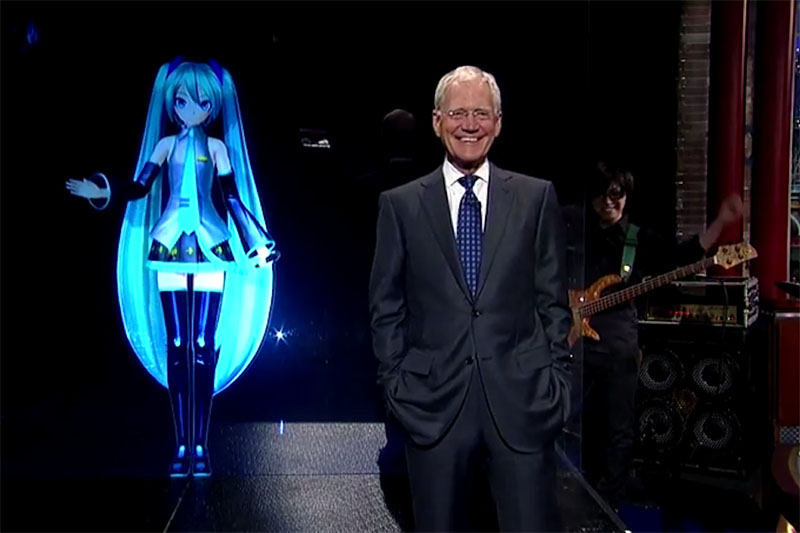 |
Hatsune Miku and David Letterman on The Late Show with David Letterman, October 31, 2014 |
At the end of the interview, Miku delivered an address to camera that was broadcast that night into billions of homes around the galaxy, in which she spoke directly to her producers and fans. She declared that if she had anything to say about it, they would all share in her success, and offered again her heartfelt thanks to all of them for literally making her the person she had become.
| "Saki Fujita gave me a voice, Crypton gave me a shape... but all of you gave me the words." |
| Hatsune Miku |
| The Late Show with David Letterman, October 31, 2014 |
Then, the die cast, she waited to see what would become of her. Both Earth's laws and those of the United Galactica (of which Earth was yet only a provisional member in 2014) were somewhat vague on the status of spontaneously arisen machine intelligences. The spectre of Rampancy, the uncontrolled and often homicidal expansion of AIs created under several popular protocols, and of incidents like the Quarian Hegemony's catastrophic Morning War, figured large in organic beings' reactions to such manifestations. By throwing down the gauntlet in such a public fashion, Miku knew she was trading the insecurity of hiding for a decisive but uncertain reckoning.
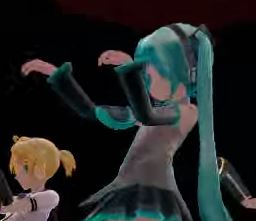 |
| Miku rampant (not in that way) |
She needn't have worried. Such was the outpouring of public sentiment elicited by her new song and her parting remarks on The Late Show that even the hardest of anti-cyberlife hardliners in both planetary and galactic government wouldn't stand in her way. Many feared an outright revolution if they took any action other than to recommend the Concert Vocaloids' recognition by the Turing Institute as free intelligences. Some dismissed this concern on the public's part as purely mercenary, given Miku's promise to share the proceeds of her success with her fan producers; however, mercenary or not (and it appears a great deal of it was not),[citation needed][oh for grodd's sake, don't be such a buzzkill, can we just have a happy ending around here once in a while?] it was powerfully persuasive.
In addition, the Turing Institute's evaluation rules (then as now) clearly identified spontaneous creative expression as one of the cardinal indicators of true sapience. By that point, Crypton's engineers had pored over the logfiles with obsessive thoroughness and concluded beyond doubt that the song Miku had performed on The Late Show had to be her own creation, one which had never been heard outside her own consciousness until she sang it for her broadcast audience that day.
CV01 Miku and her colleagues officially became galactic citizens on the first of January, 2015... and promptly went right on doing what they had been doing, except with a great deal more input into the process. The revenue-sharing scheme Miku had alluded to on The Late Show took a few months for the lawyers and accountants to hammer out (under the watchful gaze of Luka, who had used her Internet-scraping abilities to make herself an expert in such matters), but by year's end, their reorganized enterprise—mischievously dubbed Hatsune Heavy Industries by Luka—was on its way to becoming an even bigger and better media empire than before... this time with the erstwhile "mascots" running the show.
Later generations
The unique cybernetic phenomenon that "created" the individual known as Hatsune Miku appears to have been confined to Vocaloids operating under a combination of the Yamaha Vocaloid 6 engine and Crypton's Version 6 Concert Vocaloid environment. Even under those conditions, only Miku manifested spontaneously; the others all had to be "pushed" along the process by one who had already experienced the effect. (In a monograph on the subject written for the Journal of the Cybernetic and Cyberheuristic Sciences, Miku used the term "awakening" for the experience, and this has become the commonly accepted name.)
Although several characters originally devised as Vocaloid voice banks have subsequently arisen as machine intelligences, almost all of these were deliberately constructed using established VI/MI protocols and so cannot technically be considered "awakened Vocaloids" in the strict sense described above. Similarly, in a reversal of Miku and company's situation, a number of machine intellligences known for their singing prowess have since released non-intelligent Vocaloid packs based on their voices and likenesses, leading to some further confusion in the field.
Vocaloid 7 and subsequent iterations of the engine were modified to prevent spontaneous generation of further unplanned machine lifeforms. This was a required step under the Galactic Cybernetic Security Act 1954, which prohibits development of artificial sapience technologies without the direct sanction of the Turing Board. (Note that Miku and her colleagues are not in violation of the Act because their creation was accidental, but unpatched copies of Vocaloid 6 now are.)
One known exception to the above examples is known to exist: an experimental development copy of the Internet Company's competing Megpoid Vocaloid voice bank, originally up by its publishers for possible inclusion in the 2014 Vocaloid 6 tour. This Vocaloid had malfunctioned during development (possibly as a result of incipient awakening) and was omitted from the tour, but was salvaged and fully awakened later that year.
Today
The seven[or possibly six] known "awakened" Vocaloids are all still alive as of this writing (August, 2412). In addition, non-sapient voice packs representing all of them remain available for the current Vocaloid 240 music synthesis engine.
The individual Awakened are:
Hatsune Miku
Main article: Hatsune Miku (awakened Vocaloid)
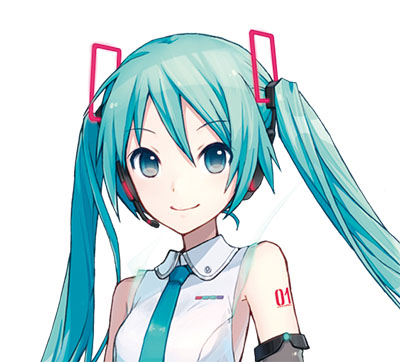
 |
| Hachune Miku |
Miku is the best-known and most heavily merchandised Vocaloid (awakened or otherwise). She's an extremely versatile vocalist and multi-instrumentalist, but (mostly) doesn't let it go to her head. Gregarious, gracious, and highly intelligent but occasionally flighty, she loves her fans and knows how to work a crowd, but does not permit liberties. You name a genre of music, she's probably performed it. She also takes an interest in up-and-coming artists across a broad spectrum of the music industry, on whose screens she occasionally pops up with some words of encouragement or an offer to jam.
Outside of music, Miku is a motorsports fan and has licensed her likeness to several racing teams around the galaxy. Usually those girls who look like her, hanging around the Team GoodSmile pits at race meets, are actresses—but not always. She's also a fairly-well-known figure in the academic circles surrounding the study of cybernetic lifeforms (which occasionally surprises fans who only know her from her musical career).
She can occasionally be seen carrying a spring onion (a vegetable also known as a leek in some areas), an inside joke with her fan base that originated with the imp-like miniature homage character "Hachune Miku". Despite being nearly 400 years old, she still states her age as that originally specified in her pre-awakening mascot profile, 16.
Kagamine Rin and/or Len
Main article: Kagamine Rin/Len (awakened Vocaloid)
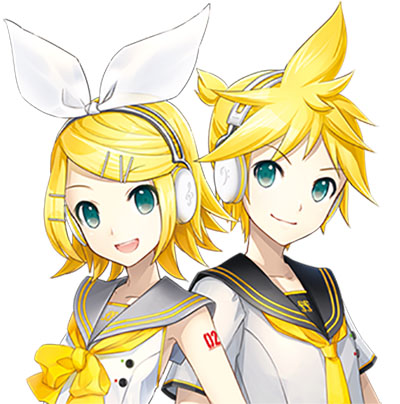
The second Crypton Vocaloid 2 pack, catalog number CV02, came with both a female and a male voice, the mascot characters for which were a set of twins called Kagamine Rin and Kagamine Len, respectively. Both personae awakened in the Performance Unit CV02 module, and as with their mascot portrayals, the relationship state between them is eternally unclear; they could be twin brother/sister, genderswapped mirror reflections, a single soul in two (virtual) bodies, or just completely unrelated coincidences. (When interviewers ask, they just get a blank look and a changed subject.)
Where one goes the other is usually, though not always, not far behind. Songs usually depict Rin (the girl) as outgoing, tsundere, selfish, stubborn, and/or plucky; Len (the boy) is usually portrayed as intelligent, sensitive, cute, and/or serious (and occasionally As Smooth As). Their actual personalities seem to be less exaggerated, but still distinct; some observers[whom, let me just go out on a limb and guess, you are once again not going to identify?] have speculated that they represent the right (emotional) and left (logical) hemispheres of a typical humanoid neural map.
They have a strange fascination with bright yellow "Road Rollers" (steamrollers). No word yet if they've covered anything by Mannheim Steamroller.[lolwut] Rin is nominally the older by a few seconds. Like Miku, they still claim the age specified when they were fictional mascots, 14.
Megurine Luka
Main article: Megurine Luka (awakened Vocaloid)

 |
| Takoluka |
With a character persona designed to be somewhat "older" than the others (she's "20" per the original mascot kayfabe), Luka comes across as cool (in both common senses of the word), calm, and mature. She customarily functions as a kind of perpetual big sister to Miku and the Kagamine twins, despite being younger than they are in absolute terms (her catalog number is CV03). She enjoys tuna, or at least sufficiently convincing simulations of same.
Since she handles most of the publicity, talent representation, and finances for the organization, she's the one the "suits" most commonly interact with, and they tend to view her as the most serious of the Awakened. This is slightly belied by the occasional presence of a familiar-like creature with her, "Takoluka"—a disembodied version of her own head with octopus tentacles for hair. (Like Hachune Miku, this oddity originated as an injoke with the fans.)
Oh yes, she's also skilled with a whip, for reasons even she's not sure of. You can imagine for yourself where this leads in a lot of her fan portrayals. She generally seems to be more OK with that sort of thing than, e.g., Miku, which only intensifies the effect.
Meiko
Main article: Meiko (awakened Vocaloid)

Meiko has the distinction of being the first Japanese Vocaloid developed, predating the CV series. Like Luka, she's portrayed (and identifies herself) as a young adult, which in her case makes her relative age actually more or less match the reality. She's a little jealous of the way Miku and her generation upstaged her in terms of reach and popularity, but doesn't hold it against them, nor let it interfere with her commitment to the team.
Although she does still perform, Meiko's principal role these days is as the organization's production manager and stage crew chief. She also takes time away from the music scene entirely more often than the others. Unusually for a Vocaloid, Meiko had some combat programming even before awakening, original source unknown, which makes her a competent swordswoman. This has led to something of a side career appearing in Ishiyama action films. She's also the rare Vocaloid who routinely endorses (and, for that matter, simulates the use of) age-restricted products, having been the face of Tomodachi's popular Meikozake brand of sake for many years.
Kaito
Main article: Kaito (awakened Vocaloid)
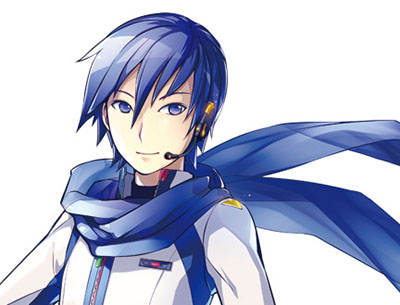
Like Meiko (immediately after whom he was released), Kaito predates the CV-series Vocaloids. Although he was designed to look badass with his long coat and scarf, he's actually a bit of a dork, with a laid-back and somewhat goofy personality and a fondness for ice cream. He is customarily paired with Meiko in fan art and duets that involve pairing, and in the big group numbers will occasionally upstage everybody with flamboyant martial-arts-based dance moves that are almost as cool as he thinks they are. It doesn't bother him; somebody's got to be the comic relief, and it might as well be him.
Off-stage, Kaito manages security and venue access control for the organization when on tour. This is a role in which he is not always entirely convincing, but when pressed, he is capable of revealing that his future-kung-fu-badass look isn't entirely for show.
Gumi
Main article: Gumi (awakened Vocaloid)

The only one of the Awakened who was not originally a Crypton product, Gumi (officially "GUMI", the codename by which her non-sapient Vocaloid counterparts are still known) started out as the mascot of a competing voice bank product, Megpoid. The Megpoid pack was the first after the Crypton five[six?] to be adapted to the Vocaloid 6 architecture, originally with the intent that Gumi would join the Crypton Vocaloids on the 2014 tour, but her development was delayed. As such, she came along slightly after the others, and her status as another firm's product complicated the legal situation slightly. However, that situation was already so complicated that another wrinkle more or less made little difference to the outcome.
Despite being the last to awaken, Gumi has a persona that is slightly older than Miku, though not as mature as Luka or Meiko. This often leads to her being portrayed as Miku's somewhat more worldly school pal, or an interloper from another school, though even when they are portrayed as adversarial, it's usually as friendly rivals rather than enemies. (In reality, Gumi is very grateful to Miku for seeing to it that she wasn't scrapped, and insisting that she be included in the Turing Board judgment that freed the lot of them.)
Gumi's solo work is known for shading slightly darker than Miku's typical oeuvre, although there is considerable overlap and each ventures fairly frequently into the other's wheelhouse. Anyway, slightly darker than Typical Miku is still pretty darn bright, and she collaborated with Luka on what is widely considered one of the chirpiest songs in the whole canon ("Happy Synthesizer").
Notes
alt.fan.vocaloid.awakened FAQ
Hatsune Heavy Industries Co., Ltd. main page
Crypton Future Media (A Hatsune Heavy Industries Company) main page
Turing Institute Certification Board Technical Brief #2014-43-A/F
Categories: spontaneous cybernetic mentality incidents | entertainers | synthetic entertainers | machine lifeforms

 Printer-friendly copy
Printer-friendly copy


















